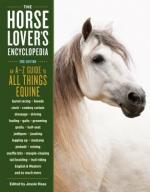July 15, 2018 | sobczakd
July 15 is National I Love Horses Day! Today celebrates these majestic, magnificent animals and provides a great opportunity to learn more about them. There are over 350 breeds of horses and ponies throughout the world. Horses have been around for millions of years, but was only domesticated around 10,000 years ago. The horse-human connection is a special bond. Want to learn more? Check out one of these books from our pet collection or visit a local riding stable!
More than 1,700 entries as well as photos and drawings of running, jumping, and gamboling horses, equipment, and anatomy-on just about every page. The shortest entries are a single sentence, and most are between a paragraph and a page or more in length. Haas writes horse-themed fiction for young readers and has a pleasing and direct style in this nonfiction endeavor. She covers English and Western riding, the history of the horse, some basic equine medical issues, training terminology, and details about horse breeds and coloration.
Perhaps no other species in its 5,000-plus years since domestication has been associated with humans in more ways than the horse. Author Forrest, an equestrian expert, cautions that her book "is not a history of the horse"; rather, it is a multifaceted account of the diverse aspects of human-horse interactions on a worldwide scale, from both a historical and a contemporary perspective. The text is well researched and well written, but an unabridged dictionary will be a handy companion if the reader is to fully understand the numerous references to little-known historical people and places. Forrest has traveled widely to prepare for this book and has selected a half-dozen diverse topics to feature. These include polo in China, a horse-powered organic farm in Massachusetts, the reintroduction of horses into the wild in Mongolia, and 18th-century and contemporary use of horses at Versailles. An extensive bibliography can lead the interested reader in this and many other equine directions.
Award-winning author and celebrated neurosurgeon Allan J. Hamilton combines his understanding of the human brain with nearly 30 years' experience training horses to offer wisdom on such universal themes as leadership, motivation, ambition, and humility. The results are showcased in more than 100 thoughtful essays that treat working with horses as a metaphor for personal, professional, and spiritual growth. Whether you're searching for greater spiritual depth or simply want to better understand your four-legged partner, this wise and important collection has something for you.
The Horse Encyclopedia is a comprehensive photographic guide to more than 150 horse and pony breeds and types from around the world. Browse through the catalog of gorgeous photographs and learn about the characteristics and origins of each breed, from Friesians to Thoroughbreds, and some of the most famous horses that left a mark on equine history. A fascinating introduction takes you through the evolution of the horse, horse disciplines like polo and show jumping, the animal's place in history, art, culture, and much more. With expert advice on horse health and care, including feeding, grooming, and conditioning, The Horse Encyclopedia can even guide you through the experience of becoming a first-time owner. The Horse Encyclopedia is a visually stunning celebration of all things equine and a must-have for every horse lover.
In The Secret Language of Horses & Ponies you'll learn about horse breeds and types, riding disciplines, horse communication, grooming, and care. It's packed full of practical advice on everything from selecting your first horse and choosing appropriate tack to maintaining a healthy horse and understanding his needs as he matures. It's everything you need to know, and the key to a contented horse and a confident owner.
The dog may be man's best friend, but humanity has a long and storied history with the horse, as well. And well before humans came into the picture, horses were developing an evolutionary legacy all their own. As she did with her squid history, Kraken (2011), Williams takes a narrative approach to the science of the horse, harking back some 50 million years to the age of the dawn horse, the dog-sized, multitoed ancestor to the modern equine. Williams details her conversations with various experts and her own visits to archaeological digs as she navigates the evolution of the horse, its development in a variety of landscapes, and its general adaptability. The first half is fairly science-heavy; the second delves into the relationship between man and horse and the behavioral aspects of the latter. The last chapter, on the reintroduction of wild horses in Mongolia, provides the emotional crux of the text and pays homage to the lasting endurance of horses and of our fascination with them.





